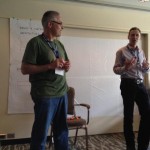 This past weekend Agile Coach Camp Canada was hosted in Toronto. I was excited to see so many new faces this year! While there were many debates about No Estimates, I’d have to estimate about 1/4 of the crowd were non-coaches or practitioners which is fantastic. For those of us who are coaches/consultants/practitioners, attending these events is a way of life so I was excited that so many people outside the community gave up a weekend, and Father’s Day, to learn how to bring Agile into their organizations. As you can see, I still managed to dress up for Father’s Day and was often referred to as the manager who has to clean up the mess!
This past weekend Agile Coach Camp Canada was hosted in Toronto. I was excited to see so many new faces this year! While there were many debates about No Estimates, I’d have to estimate about 1/4 of the crowd were non-coaches or practitioners which is fantastic. For those of us who are coaches/consultants/practitioners, attending these events is a way of life so I was excited that so many people outside the community gave up a weekend, and Father’s Day, to learn how to bring Agile into their organizations. As you can see, I still managed to dress up for Father’s Day and was often referred to as the manager who has to clean up the mess!
There is Room for Architecture!
 The highlight for me was the session hosted by Paul Whelan and that other Whelan brother. I think his name was Declan. 😉
The highlight for me was the session hosted by Paul Whelan and that other Whelan brother. I think his name was Declan. 😉
The premise was that bricks and mortar architecture has been around a few centuries more than software architecture and was there something we, in software, could learn from them. The short version is, in both cases, shorten feedback cycles as much as possible and use stories, metaphors and graphics to convey your designs. What was clear to me was that we often take too much of a construction focus too early in software and bricks and mortar architects are often given solutions the same way software teams are.
For example, Paul mentioned a typical ‘inception’ of a new building could be “we need a hospital with 400 beds, 150 eye wash stations, 100 bathrooms, a big glass atrium…etc etc“. To me, that sounded a lot like “we need a new intranet and it must use Sharepoint“.
Here are some of the similarities I picked out:
B/M: Keep the designs ‘fuzzy’ initially to provoke conversation
S/W: Use lo-fi prototypes, whiteboard drawings etc.
B/M: Use “crits”, which are sessions where the architect is getting feedback on high-level designs from all stakeholders
S/W: Use demos (in Sprint 0 scenarios) to get feedback from customers
B/M: Use “construct-ability reviews” to find out if the design is feasible, if the building material exists etc.
S/W: Use “spikes” to do a small implementation to prove your approach can work
One of the most common arguments was in software people expect changes to happen at anytime so we can ‘be Agile’ but in building construction you can’t do that. Paul debunked that myth because he sees it happen all the time. It’s managed the same way as we do in software. Evaluate the change, compare it to what budget is left, what the impact is and make a decision.
Other key points Paul mentioned:
- Sometimes if they’re stuck on building design, they’ll design a component of it like the staircase or bathroom to spark new ideas (stuck on architecture? Mockup some screens and wire them together to see how different systems will interact)
- God and The Devil are in the details, if one of them wins, Paul gets sued! (when you make a big SW architecture mistake you will be eating the cost to fix it!)
I guess this was the long way of saying, there are many things SW architecture and design can learn from the bricks and mortar world. Building design isn’t as linear as some people think, what they do is eerily aligned with Agile software development practices, especially when you’re talking about fast feedback, rapid prototyping and involvement of customers and stakeholders early.
Other Highlights from #ACCCA13
- Paul Heidema facilitated a great discussion on Agile and Lean Transformation teams. These team must work in the whitespace and must have representation throughout the hierarchy so they are not blocked by not having authority to make decisions. We can also use tools from traditional world, like Dynamic Governance, to make this happen. 3 components are needed, (1) – an outside observer or coach, (2) a team with executive backing and (3) a cross-functional transformation team with people that represent different areas of the organization.
- Alistair McKinnell brought some great ideas from the book The Dance of Change about how organizations can combat the “no time” problem when working through an Agile transformation.
- Adriana Diaz-Berrio helped me understand more about Open Space technology and how to create a container around the group to provoke sharing and openness.
There’s far too much to go through in one post! Check out all the pics, tweets and videos on Epilogger! Were you at Coach Camp? What did you think? Leave us a comment!
